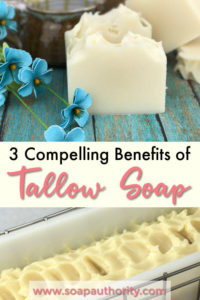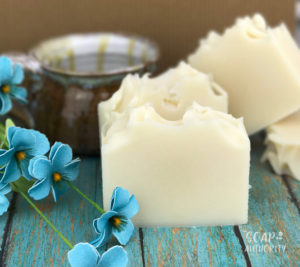I personally use tallow in soap making as much as I can when making cold process soap.
Even though there are many people who are excited to use vegan only soaps, there are three compelling reasons for using tallow when making soap.
Before we dive in, let’s back up a little to get a running start.
Tallow soap making is a craft that is thousands of years old. Preceding the era of mass production and the assembly line, people made soap at home on the farm using the leftover fat trimmings from butchering and cooking.
After they melted down (rendered) the tallow, they let it cool down and used in cooking and soap making. Once rendered, it is commonly referred to as tallow. Today, most commercial soaps contain tallow and list it on the label as “sodium tallowate.” This is a fancy way of listing an ingredient that is basically animal fat that has been soaponified (chemically turned into soap).
Here are the top three reasons for using tallow soap, plus some additional bonuses to think about!
1) Tallow is a by-product that would otherwise be wasted and thrown away.
Due to the decreased demand for beef suet and lard, many local butchers literally throw this stuff away as a waste product. The tallow ends up in a local land fill when it could have been put to use in soap making or candle making. By using tallow for soap making, you can be less wasteful.
2) Tallow makes a very skin-friendly soap.
It is mild to the skin and moisturizing. Using handmade soap with tallow will decrease your need for additional moisturizers. This helps you leave a smaller ecological footprint and avoid itchy, sore and chapped skin. Just ask my daughter who happens to be an O.C.D. hand washer.
3) It helps protect and save animals.
The closest alternative to palm oil in soap is tallow. There is a huge, heated debate in the soap and cosmetics community about palm oil and it’s devastating effects on wildlife due to deforestation. Large swaths of natural habitats are being destroyed and planted with palm kernel trees because of the demand. A better alternative is sustainably-sourced palm oil, but there is another problem with sustainably-sourced palm oil. Read more about the problems with sustainably-sourced palm oil here.
Palm oil may be contributing to the deaths of endangered species by considerably reducing their habitats. When you use tallow, you are using the by-product of an animal that was farm raised specifically for consumption. If the cow is going to be butchered anyway, why throw away the suet in favor of palm oil?
Using tallow is a sustainable, environmentally friendly, and smarter alternative to palm oil.
Some of you may be thinking it’s anti-vegan or vegetarian to use tallow. It’s totally fine not to use tallow if you choose not to, but it won’t save any cows. If our doctors can’t convince their patients to reduce their intake of red meat to save THEIR OWN lives, how could beef eaters possibly be convinced to do it for the animals?
Now, if you’re a vegan or vegetarian because of religious or personal beliefs, then make your choice according to that! If it’s for health reasons, there are no adverse health effects from using tallow soap. Maybe your choice is an animal rights choice. If so, then tallow is still a better choice than palm.
If you eat meat, there is no reason for you to go tallow-free in your cosmetics.
It’s kind of funny when meat eaters say it’s “gross” to put that on your skin, forgetting that they put it in their mouth and stomach.
As for the whole ethical and moral debate goes, I will still be your friend regardless of your position. It’s not worth fighting about. I just think it pays big dividends to better understand what you stand for and why. I happen to be a trash to treasure kind of gal.
Besides, palm oil is a pain in the butt to use in soap!
Palm oil has to be remelted and stirred before each use to re-incorporate and evenly distribute the palmitic acid before you measure it out for your soap recipe. Otherwise, your soap won’t turn out as expected. Some batches will have less palmitic acid and some more. Each time it cools, the palmitic acid migrates and settles. Extra steps in soap making just isn’t my thing.
The tallow we use in our soaps is from a local family butchering business. This local butchering business serves small farms in the area, not large commercial farms. We do not pay for the tallow. It is a waste product that would otherwise be thrown away. We do the labor-intensive process of rendering it ourselves for our handmade soap.
It puts us in touch with our heritage and gives us an appreciation of our ancestors. We feel that we are honoring the animal’s life by making use of more of the animal that would have perished whether or not we used the tallow to make soap. If you include meat in your diet, we encourage you use tallow soap. We love animals and have a lot of wonderful pets. We believe all animals should be well-cared for and whenever they are to be put down, it should always be done in a humane manner.
What do you prefer in your soap? I’d love to hear about your views!
VIDEO TUTORIAL >> If you would like to learn how to render fat trimmings into the beautiful tallow used in soap making, I have a 3-part video series that walks you through the process step-by-step here:
How to Render Tallow for Soap Making



Please could you send me a recipe to make tallow soap…. live on a farm in Limpopo South Africa and have plenty left over fat…….
what a way to use this extra product
would really appreciate
Hi Marita! If you are talking about beef tallow, the good news is it can be substituted into any recipe that calls for palm oil (not palm kernel oil- that’s different). So, if it calls for 15 ounces of palm oil, you can use 15 ounces of beef tallow instead. Both have similar properties in soap and have a nearly identical Saponification value.
Here is a recipe that I’ve used. It’s based on The Soap Queen’s “Old Faithful” recipe.
10.8 ounces coconut oil
10.8 ounces olive oil
10.8 ounces beef tallow
1.4 ounces castor oil
4.85 ounces lye
11 ounces distilled water
I like to mix my lye solution into my melted oils when both have reached about 105 degrees Fahrenheit.
If you want to use beef tallow as your only fat, here is a recipe for that:
30 ounces beef tallow
4 ounces lye
10 ounces of distilled water
You might want to mix at higher temperatures (around 115 degrees Fahrenheit) since tallow has a higher melting point.
Good afternoon. I am just beginning soap making and would like to know if you could replace the water for frozen kefir milk in this recipe
Yes, you can use frozen kefir milk instead of water in a soap recipe. Just be aware that kefir with added sweeteners can accelerate trace and if it’s a commercial kefir milk with additives, those could change how your soap behaves/turns out.
I love this article, as I share your views. I see how we are becoming an increasingly more wasteful society, overall, as we label certain things “good” or “bad”. As in, the “good” gets overproduced by any means necessary and the “bad” gets discarded when it could have been useful in another application. Even though I have been decreasing my meat intake – for health reasons, I value the usefulness of animal products for things other than consumption.
Anyway, would you happen to have or know where I can find a resource on how to render tallow? I’m new to soap making and would like to make some myself. Also not a fan of buying ingredients that have such limited use in my household. I already buy many natural oils and butters for use in my hair and cooking, not interested in buying palm oil just for soap. I appreciate your insights and any help you can offer.
Hi, Katrina! I’m so glad you found it helpful! I’ve really decreased my meat intake too and for health reasons. 🙂 You have perfect timing, because I just finished video recording my process for rendering tallow. A family member brought home a mule deer recently and I rendered it and made soap with it. I’m working on editing the videos and will be uploading them very soon – yay!! I’ll also be including some recipes. When I am done I will contact you directly so you don’t miss out. I’m so excited you’ve started in soap making!
Outstanding points! Using a resource that would be thrown away versus something that leads to deforestation. Besides, tallow soap is awesome!